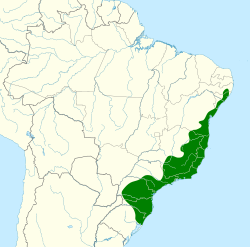Systematics
The name Pseudastur was coined by Edward Blyth, but was first published in George Robert Gray's Index. [1] [2] [3] [4] The type species is the white hawk, Falco albicollis Latham, 1790.
The species were placed for some time in the genus Leucopternis , however this genus was found to be polyphyletic. In 2012 the American Ornithologists' Union split Leucopternis, placing the white hawk and its relatives under the old name Pseudastur. [5] The genus contains the following species:
Genus Pseudastur – Gray, 1849 – three species| Common name | Scientific name and subspecies | Range | Size and ecology | IUCN status and estimated population |
|---|
| Mantled hawk  | Pseudastur polionotus
(Kaup, 1847) | Argentina, Brazil, Paraguay, and Uruguay
 | Size:
Habitat:
Diet: | NT
|
|---|
| White hawk  | Pseudastur albicollis
(Latham, 1790)
- P. a. ghiesbreghti - (Du Bus de Gisignies, 1845)
- P. a. costaricensis - (Sclater, WL, 1919)
- P. a. williaminae - (Meyer de Schauensee, 1950)
- P. a. albicollis - (Latham, 1790)
| southern Mexico through Central and South America to Peru, Bolivia and Brazil
 | Size:
Habitat:
Diet: | LC
|
|---|
| Grey-backed hawk  | Pseudastur occidentalis
(Salvin, 1876) | Ecuador and far northern Peru
 | Size:
Habitat:
Diet: | EN
|
|---|
This page is based on this
Wikipedia article Text is available under the
CC BY-SA 4.0 license; additional terms may apply.
Images, videos and audio are available under their respective licenses.









